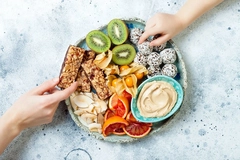SPECIAL REPORT: Industry Responds to the Elimination of PHOs in the Food Chain
05 Sep 2016 --- The clock is counting down to June 2018, the deadline set by the US Food and Drug Administration for sweeping industry changes concerning partially hydrogenated oils (PHOs). Last year the FDA ruled that PHOs are no longer fit for human consumption and must be removed from products after losing their GRAS (generally recognized as safe) status.
From the time of the announcement, the industry had roughly three years to respond and comply. FoodIngredientsFirst takes a closer look at the situation as the food industry goes through reformulations and heads towards a supply chain that eliminates PHOs.
What are PHOs?

Food oils that have extra hydrogen added to improve shelf life and make them easier to handle. They include (but are no way limited to) processed food, baked goods, cakes, cookies, pie crusts, frostings, certain margarines and more. However, food with high levels of trans fats have been scrutinized for many years and are subject to labeling and legislative measures in many countries - the US being one latest example.
According to the World Health Organization (WHO), the removal of PHOs from the food supply would result in significant health benefits for the population. Earlier this year a WHO review detailed the effects of trans-fatty acid intake on blood lipids and lipoproteins with results showing that replacing them with other macronutrients, particularly polyunsaturated fatty acids, has a favorable effect on the blood lipid profile, including lowering of LDL cholesterol levels.
Meanwhile the Center for Disease Control and Prevention (CDC) estimates that PHO elimination could prevent up to 20,000 coronary events and 3,000 to 7,000 coronary deaths annually.
One such company which has already been working hard behind the scenes to expand its portfolio whilst reducing PHOs is premier global agribusiness ADM Oils and Fats.
“Our customers count on ADM for our expertise and broad portfolio as they look to reduce trans fat and meet other consumer demands. We offer a wide range of oils and fats as well as extensive oil-blending capabilities,” spokesman Jackie Anderson tells FoodIngredientsFirst.
“Our fully hydrogenated and enzymatically interesterified oils and shortenings provide lower trans fat solutions while preserving the same functionality and stability as other oils.”
“We also offer naturally stable oils for superior consistency and taste, high oleic for longer fry life, lauric oils as a flavor and structuring product, and a full line of palm oil products.”
Global leader Cargill has been working for more than two decades to market the next generation of healthier fats and oils and has worked with more than 300 manufacturing partners to move away from PHOs without sacrificing quality since 2011. Speaking with FoodIngredientsFirst, Lynne Morehart, Oils and Shortenings Senior Principal Scientist, Cargill, says many companies have largely eliminated PHOs, but partnering with an experienced ingredient supplier is vital.
“Cargill has multiple PHO-free shortening options available today. They include palm-based shortenings, interesterified shortenings, palm/liquid oil blends and liquid oil/fully hydrogenated blends. These products can be used in some of the most challenging PHO-replacement bakery applications, including cookies, frostings, laminated doughs and pie crusts,” she says. “In truth, food companies have largely eliminated trans fats, relegating structuring capacity almost exclusively to saturated fats. Because health concerns also surround saturated fats, Cargill researchers are exploring other options, still in development.
“For example, Cargill is working to further reduce saturated fat levels in canola oil. This lower saturated fat, high oleic canola oil could then be added to palm hard fraction, diglycerides or fully hydrogenated fats so that structure is added.”
“We work with our customers to understand their applications, as well as labeling and nutritional parameters, to help them determine which choices will meet their needs. Even if customers make similar products to their competitors, their mixing, production lines or oven configurations may necessitate unforeseen tweaks to their process or to the exact shortening that will work for them. It is not always possible to anticipate these types of differences. A close working relationship between supplier and customer is critical at those times.”
“The vast majority of food manufacturers removed partially hydrogenated products, therefore trans fats formed during partial hydrogenation, several years ago. The tougher applications of frostings, puff pastry, Danish, pie crusts and some cookies need to have solid fat to aid in the appropriate structure of those products. “Non-PHO products tend to need more specialization for many of these more challenging applications. They also typically require changes to manufacturing parameters, ingredients, sequence of ingredient addition or packaging materials. In these situations, it is critical for companies to partner with an experienced ingredient supplier who can help guide them through the reformulation process.”
Meanwhile, quite some time ago IOI Loders Croklaan began looking at sourcing palm oil. Dr Gerald McNeill explains to FoodIngredientsFirst how palm oil is helping to replace PHOs.
“The choice of base oil in the absence of PHO and the resultant absence of the trans fat causes great difficulty for bakery and snack food formulation. The reason for this difficulty is that PHO was effectively not just one oil, but an unlimited number of tailor made shortenings. That gave formulators the ability to innovate in unlimited ways in areas such as texture, long shelf life, speed of crystallization, fast line speeds on factory lines: the list goes on. It was a golden era for this category of foods and more.”
“For the previous 150 years, the majority of baked goods were traditionally made with natural semi-solid fats such as butter, beef tallow and lard. That base has still not changed, but just three types of fat cannot compete with the diversity and many benefits of synthetic PHO. However, a relatively new edible oil has burst onto the food formulation stage, called palm oil.”
“We have developed more than 350 drop-in solutions for the bakery and snack foods industry since 2003 (in response to the mandatory labeling for grams trans fat per serving on retail goods).”
IOI’s solutions have been possible because of a physical process called fractionation where a semi-solid oil is put into a large high pressure presses that squeezes out a liquid component in the oil. It’s repeated several times and results in about 12 different components (fractions) with each fraction having a significantly different physical property and they can be blended together.
In this, says McNeill, the palm oil can almost exactly match all of the partially hydrogenated oils of the past, with none of the trans fat.
“Palm oil is obtained by pressing an edible oil from the fruit of a palm tree that grows within 10-20 degrees of the equator. The palm oil has a semi-solid texture at room temperature, similar to animal fats. However, the oil palm can produce an enormous volume of palm oil, producing 10 fold greater volume of palm oil per acre, per year generated by soybean oil, for example. Clearly palm oil is the most readily available oil in the world, that is suitable for baking and snack foods. The natural oil does not contain any trans fat.”
Loders Croklaan has explained the urgency of the situation to its client base, urging companies to take action to eliminate PHOs as soon as possible, before the 2018 deadline.
Corbion has been reformulating away from PHO for several years as well to maintain the functionality and quality of products by using non PHO based portfolio including emulsifiers geared towards many different applications including the bakery segment. It showcased an array of products like muffins, ice-cream and bread-based products at last year’s Institute of Food Technologists (IFT) event and more recently invested in a new Illinois-based plant to offer propylene glycol monoesters (PGME) to be used in sweet goods, bakery mixes and other applications.
“The addition of PGME to the portfolio means Corbion will possess all the necessary building blocks to produce a sweet goods portfolio that matches the breadth of solutions we currently offer to the bread market segment,” says global product manager, emulsifiers, Jim Robertson.
This new plant follows Corbion’s earlier investment in its Missouri plant to develop and commercialize the Ensemble non-PHO emulsifier portfolio. The company estimates to have PGME solutions available in the second quarter of next year.
“As the food industry evolves, Corbion’s knowledge and experience can help our customers make transitions smoothly and easily. By adding PGME solutions for sweet goods and offering drop-in non-PHO replacement, Corbion minimizes challenges for our customers and makes it easier for them to provide the delicious foods their consumers demand.”
In May the International Food and Beverage Alliance (IFBA) - made up of the world’s biggest food and non-alcoholic drinks companies including The Coca-Cola Company, Ferrero, General Mills, Grupo Bimbo, Kellogg, Mars, McDonald’s, Mondelez International, Nestlé, PepsiCo and Unilever - took another step in progressing the commitments they first made in 2008 with the adoption of a worldwide commitment to phase out industrially produced trans fatty acids (TFAs).
According to the IFBA, its members have been voluntarily getting rid of PHOs through reformulation and increasing the use of healthier fats such as mono- or polyunsaturated fatty acids in order to support informed dietary choices amongst consumers. The companies have also been listing trans fat content on labels.
While Centers for Disease Control and Prevention (CDC) acknowledges behind the scenes work of the food industry, a spokesman tells FoodIngredientsFirst that more needs to be done to remove PHOs from certain food categories.
“The packaged and restaurant food industries have been working for some time to decrease the amount of partially hydrogenated oils (PHOs) in foods, e.g. through reformulation, with significant results. However, there are still a number of foods that may contain PHOs, notably crackers, cookies, cakes, frozen pies and other baked goods, snack foods (such as some microwave popcorn), stick margarines, coffee creamers, refrigerated dough products (such as biscuits and cinnamon rolls), and ready-to-use frostings.”
“The FDA has now given food manufacturers three years to phase out partially hydrogenated oils from their products, after an initial determination that PHOs do not qualify as GRAS (generally regarded as safe). Removing PHOs will reduce dietary sources of trans-fats, the intake of which has been linked to heart disease.”
by Gaynor Selby













